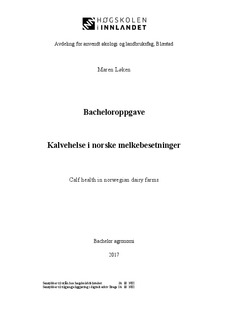Kalvehelse i norske melkebesetninger
Bachelor thesis

Åpne
Permanent lenke
http://hdl.handle.net/11250/2447200Utgivelsesdato
2017Metadata
Vis full innførselSamlinger
Sammendrag
Det har i flere år vært økt fokus på smittepress, kalvehelse og optimalt oppdrett av kalv. Mer
fokus rundt dette har gjort at næringen har fått en økt bevissthet for hvor mye penger syke
kalver koster, både i klinisk sykdom, og også i tapte produksjonsinntekter i form av lavere
avdrått og tilvekst. I tillegg til dette vet vi at dyr som har vært syke i ung alder blir mindre
holdbare som melkekyr og har større risiko for mastitt og andre produksjonssykdommer i
voksen alder (Ellingsen, et al, 2015). Kalvehelse og dyrevelferd er også en viktig faktor med
tanke på næringens renommé.
Store besetninger har større risiko for høyere smittepress og dårligere kalvehelse men også
de mindre besetningene opplever sykdom og tidlig død på kalv. Økt fokus har vært, og er
viktig for å få oversikt over helsestatusen hos kalver i norske besetninger samt å redusere
antall sykdomsutbrudd (Gulliksen & Schei, 2013). Det økte fokuset er særdeles viktig for å
kunne peke på hvilke faktorer som er av størst betydning for om, når og hvordan smitte og
sykdom oppstår.
Helsekortordningen er et viktig redskap for å få en bred og god oversikt over utbredelse av
de forskjellige kalvesykdommene. I årsrapport 2016 for helsekortordningen ser man at diaré,
uspesifikk luftveislidelse og leddbetennelse er de mest rapporterte lidelsene på kalv
(Helsetjenesten for storfe, 2016a).
Høsten 2016 startet Helsetjenesten for storfe opp et kontrollprogram for å få kontroll over
utbredelsen over BRSV/BCoV og redusere antall sykdomstilfeller. Dette er et veldig viktig
arbeid for å få redusert smittepresset i norske besetninger samt å få økt fokus og kunnskap
om hvordan og hvorfor smitten sprer seg. Sammen med registreringer i Helsekortordningen
er dette med på å få en god oversikt over sykdomstilfeller i melkebesetninger i Norge.
For å sikre kalven en god start er råmelk svært viktig. Både mengde, tidlig tildeling og
kvaliteten på råmelka er av vesentlig betydning for kalvens motstandskraft mot smitte, samt
for å unngå tidlig død. Tidligere har det vært anbefalt å ikke gi kalven mer enn 2,5 liter med
råmelk/melk per tildeling fordi man mente at melka ville renne over til vomma og skape
feilgjæring. Etter å ha lest ulike studier i forbindelse med denne oppgaven viser det seg at
forskerne nå sier det motsatte. Kalvene kan gis rasjoner på opptil 5 liter per rasjon uten fare
for lekkasje til vomma. Dette er ganske revolusjonerende med tanke på tilvekst og helse på kalv (Ellingsen, et al, 2015).
I tillegg til fokusområdene melkefôring og smittepress er også hygiene en faktor som spiller
en viktig rolle, både for smittepresset i besetningen, og også for velferden og helsen til dyra. In later years it has been an increased focus on infection pressure, optimal rearing of calves
and general calf health in the dairy industry. This has given the industry a much greater
awareness of how much sick calves influences income; not only the cost of treating clinical
disease in the calves, but also in lost revenue in the form of lower milk yield and
production. In addition to this, we know that cows who have been ill at a young age are less
durable as dairy cows and at a greater risk of mastitis and diseases That affect the milk yield
and production in adulthood (Ellingsen et al, 2015). The health and welfare of calves is also
an important factor to take into consideration when it comes to the industry's reputation.
Large herds are at a greater risk when it comes to infection pressure and lower calf health,
but smaller farms experience disease and premature deaths in calves as well. The increased
focus on this has been, and still is, very important to get an overview of the health status of
calves in Norwegian dairy farms as well as reducing the number of outbreaks of diseases
(Gulliksen & Schei, 2013). The increased focus on calves health is particularly important so
one can pinpoint which factors are most significant for whether, when and how infection and
disease occurs.
The Health Card scheme is an essential tool when it comes to gaining a broad overview of
the of the different calf diseases and how widespread they are. In the annual report for 2016
the Health Card scheme shows that diarrhea, nonspecific respiratory disease and arthritis are
the most reported diseases in calves (Helsetejensten for storfe, 2016a).
In autumn 2016 Helsetjenesten for Storfe started a program to control the spread of BRSV /
BCoV and reduce the number of cases. The program is a very important step towards
reducing the infection pressure in Norwegian herds and to increase the knowledge of how
and why the infection spreads. Along with registrations in the Health Card scheme, this
program will give a good overview of illnesses in dairy herds in Norway.
To ensure that the calf gets a healthy start in life, colostrum is incredibly important.
Quantity, early allocation and the quality of the colostrum is of significant importance for the
calf's resistance to infection, and in prevention of premature death. Previously it has been
advised not to give the calf more than 2.5 litres of colostrum / milk per assignment because it
was thought that the milk would flow into the rumen and create fermentation. After reading various studies associated with this task, researchers now say the opposite. Calves can be
given rations of up to 5 litres per ration without the risk of leakage to the rumen. This is
quite revolutionary in terms of growth and health of the calf (Ellingsen et al, 2015).
In addition to focusing on milk feeding and infection pressure, hygiene is also one factor that
plays an important role. Both for the infection pressure in the herd, but also for the welfare
and health of the animals (Nybø, 2010).